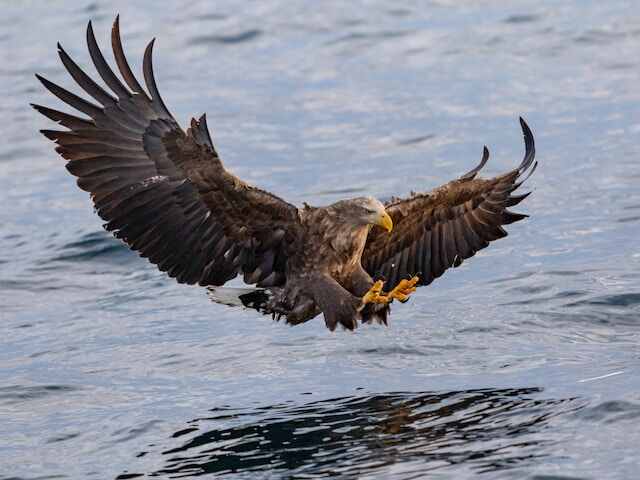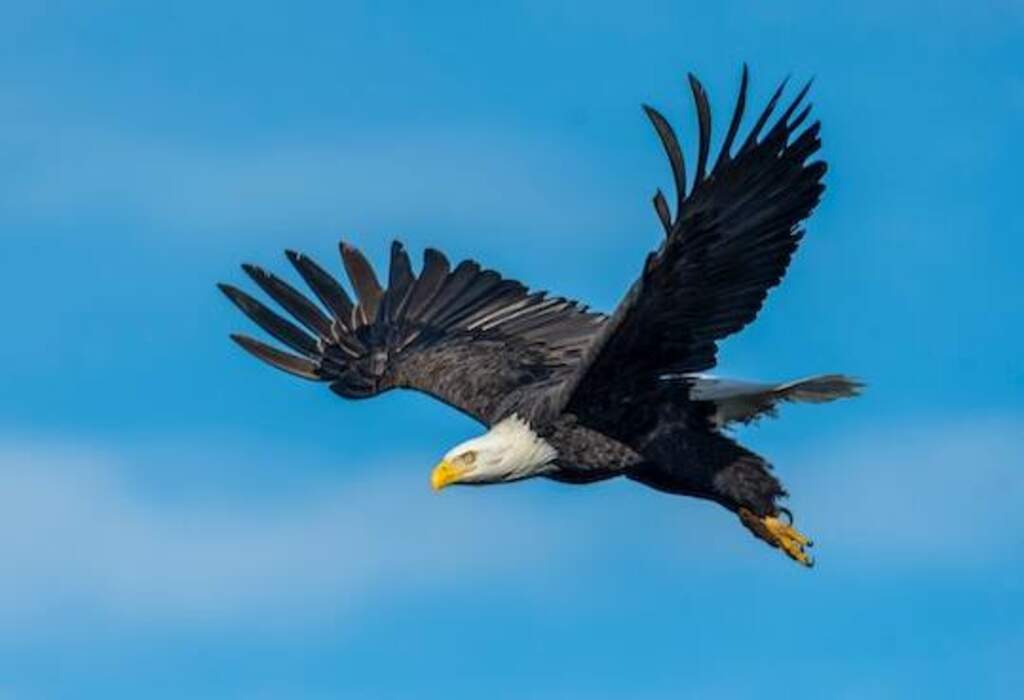Do Eagles Eat Bass? A Fishy Tale of Avian Appetites and Underwater Wonders. Amidst the awe-inspiring aerial ballet of eagles, another player lurks beneath the waves – the elusive bass.
Explore the captivating relationship between these two creatures as we dive into the eagle’s dining habits, hunting techniques, and the crucial role of bass in their ecosystem.
Get ready to embark on a thrilling aquatic adventure!
Table of Contents
- 1 Key Takeaways
- 2 The Diet of Eagles
- 3 Hunting Techniques
- 4 Impact on the Ecosystem
- 5 Do Eagles Eat Bass
- 6 Bass as a Food Source
- 7 Adaptations for Hunting Bass
- 8 Coexistence with Other Predators
- 9 The Importance of Bass in Eagle Conservation
- 10 The Role of Bass in Eagle Migration
- 11 Research and Studies on Eagle-Bass Relationship
- 12 Fascinating Facts about Eagles and Bass
- 13 Frequently Asked Questions
- 13.1 How long do eagles typically live in the wild?
- 13.2 Are there any other fish species that eagles prey on besides bass?
- 13.3 Can eagles hunt bass in both freshwater and saltwater environments?
- 13.4 Do eagles actively seek out bass or do they eat them only when they come across them?
- 13.5 How do eagles locate bass in the water before diving in to catch them?
- 14 Conclusion
- 15 Author
Key Takeaways
- Eagles have specialized characteristics and behaviors for efficiently capturing bass.
- Bass preservation is crucial for eagle conservation efforts and influences population dynamics.
- Eagles strategically position themselves near areas abundant in bass for successful hunting.
- Eagles help control the population of smaller prey species and maintain a balanced ecosystem.
The Diet of Eagles
The diet of eagles encompasses a wide range of prey species, including bass. Eagles are known to migrate long distances in search of food, making them an important part of ecosystems worldwide.
Understanding the diet of eagles is crucial for conservation efforts, as it helps identify the habitats and resources necessary for their survival.
In the next section, we will explore the hunting techniques employed by eagles to catch their prey.
Hunting Techniques
Predatory birds, such as eagles, employ sophisticated hunting techniques to secure their prey, exhibiting a remarkable ability to capture fast-moving aquatic species like bass.
These hunting techniques include aerial attacks, soaring and scanning from high altitudes, and swift dives to catch their prey.
Eagles have adaptations for hunting bass, such as their sharp talons, powerful beaks, and keen eyesight.
Understanding the hunting techniques and adaptations of eagles is crucial for comprehending their impact on the ecosystem.
Impact on the Ecosystem
With their prowess in capturing fast-moving aquatic species, it is evident that eagles possess a profound ability to significantly influence the delicate balance of the ecosystem.
This impact stems from the interdependence of species within the ecosystem, where the presence or absence of eagles can trigger a domino effect on other organisms.
Specifically, their predation on bass, a key component of the food web, can lead to changes in population dynamics, altering the availability of bass as a food source for other predators.
Do Eagles Eat Bass
Yes, eagles do eat bass. Bass, being a common and nutritious prey species, often find themselves on the menu of these majestic birds of prey. Eagles employ their keen eyesight and impressive hunting skills to snatch bass from the water’s surface or dive underwater for a successful catch.
Bass as a Food Source
Bass, a common type of fish, serves as a significant food source for various predators, including eagles.
One reason why eagles choose bass as prey is their high nutritional value. Bass are rich in protein, essential fatty acids, and various vitamins and minerals, making them an ideal food source for eagles.
Nutritional value of bass
The nutritional value of bass is an important factor to consider when examining its dietary impact on other organisms.
Bass is a good source of protein, omega-3 fatty acids, and various vitamins and minerals.
These nutrients provide several health benefits, including improved brain function, reduced inflammation, and enhanced cardiovascular health.
Understanding the nutritional composition of bass helps explain why eagles choose it as prey, as it provides them with essential nutrients for their survival and well-being.
Why eagles choose bass as prey
One interesting statistic to note is that bass is known to be a preferred prey choice for eagles due to its high nutritional value.
This eagle-bass relationship is significant in terms of eagle conservation efforts. Eagles have developed adaptations for hunting bass, which will be discussed in the subsequent section.
To highlight the importance of this relationship, the table below presents the nutritional composition of bass compared to other prey options.
| Nutrient | Bass | Prey Option 1 | Prey Option 2 | Prey Option 3 |
|---|---|---|---|---|
| Protein | High | Medium | Low | Medium |
| Fat | High | Medium | Low | Medium |
| Vitamins | Abundant | Moderate | Low | High |
This table demonstrates the nutritional superiority of bass, which explains why eagles choose it as their prey.
Adaptations for Hunting Bass
Adapting to their hunting environment, eagles have developed a range of specialized characteristics and behaviors aimed at efficiently capturing bass.
These adaptations include unique hunting techniques and camouflage abilities that enable them to blend seamlessly into their surroundings.
By utilizing their keen eyesight and sharp talons, eagles are able to spot and snatch bass with precision and speed.
However, eagles also coexist with other predators in their habitat, necessitating a delicate balance in their interactions.
Coexistence with Other Predators
In the realm of the eagle’s hunting grounds, a delicate dance of survival unfolds as it navigates the shared territory with fellow predators. One such coexistence is with wolves, who also rely on fish as part of their diet. This interaction has an impact on fish populations, as both predators compete for the same resource. Understanding this dynamic is crucial for the conservation of eagles and the preservation of bass populations.
The Importance of Bass in Eagle Conservation
The preservation of bass populations plays a crucial role in the conservation efforts aimed at protecting eagles. To understand the significance of bass in the eagle conservation, consider the following points:
- Bass serve as a primary food source for eagles, providing them with essential nutrients.
- The abundance of bass ensures a stable food supply for eagles throughout the year.
- Conservation efforts focused on bass help maintain a healthy ecosystem, benefiting not only eagles but also other species.
- Protecting bass populations ultimately contributes to the overall well-being and survival of eagles.
Now, let’s explore the role of bass in eagle migration.
The Role of Bass in Eagle Migration
One cannot underestimate the crucial role that bass play in guiding eagles during their remarkable migratory journeys.
The role of bass in eagle migratory patterns is of utmost importance, as it influences the entire population dynamics of these majestic birds.
The availability of bass directly impacts the success of eagle populations, as they rely on these fish for sustenance and navigation.
Understanding the intricate relationship between eagles and bass requires extensive research and studies, which shed light on this fascinating phenomenon.
Research and Studies on Eagle-Bass Relationship
Extensive research and studies have been conducted to understand the intricate relationship between eagles and bass, shedding light on this fascinating phenomenon.
These studies have focused on various aspects of the eagle-bass relationship, including eagle bass migration patterns and eagle bass population dynamics.
By examining the movement patterns and population trends of both eagles and bass, researchers have been able to gain valuable insights into the complex dynamics between these two species.
These findings lead us to the subsequent section about fascinating facts about eagles and bass.
Fascinating Facts about Eagles and Bass
This discussion will delve into fascinating facts about eagles and bass, shedding light on intriguing trivia about eagles and their unique behaviors related to bass consumption.
Through an academic lens, this discussion will adopt an objective and impersonal writing style, devoid of personal pronouns.
By adhering to these guidelines, we can explore the captivating aspects of eagles and their relationship with bass in an informative and scholarly manner.
Interesting trivia about eagles
Notably, eagles are known for their impressive wingspan, with some species having a wingspan of up to 7 feet.
Eagles undertake long-distance migrations, traveling hundreds or even thousands of miles each year.
They have a keen sense of sight, allowing them to spot potential prey from great distances.
Additionally, eagles have a varied diet, including fish like bass, which provide essential nutrients for their survival.
These interesting facts about eagles set the stage for understanding their unique behaviors related to bass consumption.
One intriguing aspect of eagles’ eating habits is their particular behaviors when it comes to consuming bass.
Eagles have developed unique hunting techniques to catch bass, such as swooping down from the sky or diving into the water to grab their prey.
These behaviors showcase the incredible adaptability and agility of these birds of prey.
Additionally, the consumption of bass by eagles can have a positive environmental impact by controlling the population of this species and maintaining a balanced ecosystem.
| Behavior | Description | Environmental Impact |
|---|---|---|
| Swooping down from the sky | Eagles use their sharp vision and powerful wings to spot and catch bass from above. | Helps control the bass population and maintain a balanced ecosystem. |
| Diving into the water | Eagles plunge into the water to seize bass with their talons, displaying impressive hunting skills. | Prevents overpopulation of bass and ensures the survival of other species. |
| Strategic positioning | Eagles position themselves near areas where bass are abundant, increasing their chances of successful hunting. | Helps maintain biodiversity and prevent the dominance of a single species. |
Frequently Asked Questions
How long do eagles typically live in the wild?
The lifespan of eagles in the wild can vary depending on various factors, including environmental conditions, availability of prey, and genetic predispositions. Factors affecting eagle longevity include habitat quality, predation, disease, and human activities.
Are there any other fish species that eagles prey on besides bass?
Eagles, known for their extraordinary hunting skills, prey on various fish species apart from bass. They employ a range of techniques, such as swooping down from great heights or diving into the water, to catch their elusive underwater prey.
Can eagles hunt bass in both freshwater and saltwater environments?
Eagles can hunt bass in both freshwater and saltwater environments. They employ various hunting techniques such as aerial attacks and swooping down to catch their prey. The impact of eagle predation on bass populations can be significant, affecting their abundance and distribution.
Do eagles actively seek out bass or do they eat them only when they come across them?
Eagle feeding habits demonstrate that they actively seek out bass as a food source. This behavior has an impact on the bass population, as eagles play a role in regulating their numbers.
How do eagles locate bass in the water before diving in to catch them?
Eagles utilize various methods and techniques to locate bass in the water before diving in to catch them. These include visual scanning from above, keen eyesight, and the ability to detect movements and disturbances on the water’s surface.
Conclusion
In conclusion, the majestic eagle, with its sharp talons and keen eyes, is a formidable predator in the animal kingdom. Its diet, which includes the bass, showcases its adaptability and hunting prowess.
The relationship between eagles and bass is not only crucial for the survival of these birds, but also for the balance of the ecosystem. Through research and studies, we gain a deeper understanding of this intricate connection.
So let us marvel at the dance of nature, where the eagle soars and the bass swims, forever intertwined in a harmonious symphony.








